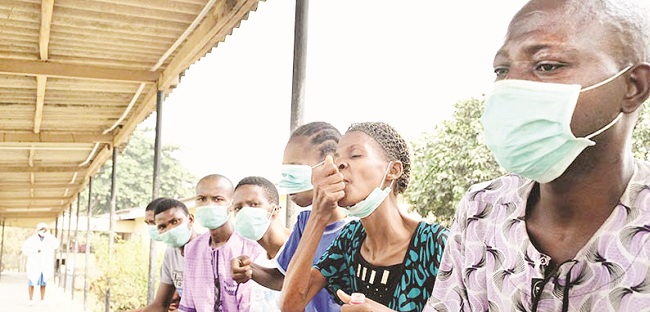Nigeria is one of the nations in the world with the highest rates of tuberculosis. There have been initiatives to bring it down to a point where it is no longer seen as a problem for the nation’s public health. JUSTICE NWAFOR writes on why the disease is still wreaking havoc despite all the efforts and what needs to be done to achieve the desired results.
In late 2019, Augustine Chukwuma, 78, was diagnosed with tuberculosis.
He was shocked because he could not fathom how the disease came about. Reluctantly, Augustine registered at the Imo State University Teaching Hospital in Orlu, Imo State, and began the long care process. It continued until the COVID-19 pandemic hit.

Movement restrictions at the time meant he could not go to the hospital to access his drugs, so he defaulted, and the disease progressed to the second and more dangerous stage: the multi-drug resistant stage.
Augustine would be transferred to a specialist unit at the Federal Medical Centre in Owerri for intensive care. After a long fight, during which he said he saw people die of the disease, he survived. Months later, he was declared clean and safe and was discharged to go home.
Tuberculosis (TB) is a contagious infection that usually attacks the lungs. The brain and spine are just two examples of other body parts where it can spread. It is brought on by a type of bacteria called Mycobacterium tuberculosis. The symptoms of the bacteria include a persistent cough that lasts for more than three weeks, chest pain, blood in the cough, feeling extremely tired all the time, night sweats, chills, fever, loss of appetite, weight loss, and more.
There are basically three stages of TB. The first is Drug-Susceptible Tuberculosis (DS-TB), which is relatively easy to treat with a four-month regimen composed of rifapentine, isoniazid, pyrazinamide, and moxifloxacin.

The second stage is Multi-Drug Resistant Tuberculosis (MDR-TB). This is caused by TB bacteria that is resistant to at least isoniazid and rifampin, the two most potent treatments for drug-susceptible TB. MDR-TB is just a step away from the most dreaded stage— Extensively drug-resistant TB (XDR-TB)—a rare type of MDR-TB that is resistant to isoniazid and rifampin, plus any fluoroquinolone and at least one of three injectable second-line drugs (amikacin, kanamycin, or capreomycin).
Also, at this stage, the fatality rate is much higher. “XDR-TB patients can be cured, but with the current drugs available, the likelihood of success is much smaller than in patients with ordinary TB or even MDR-TB,” the WHO says.
Augustine was just one of the hundreds of thousands of TB patients in Nigeria. Given that new cases of TB are diagnosed and confirmed almost daily in Nigeria, it is challenging to estimate the precise number of patients.
But one thing is certain: TB claims a significant number of lives each year. At least 157,009 Nigerians die of TB each year, and the majority of them are between the ages of 15 and 34, when people are most productive, according to Nigeria’s Minister of Health, Dr. Osagie Ehanire.
However, the Copenhagen Consensus Centre’s projections are gloomier: Around 590,000 new cases of TB (of which about 140,000 are also HIV-positive) and about 245,000 new cases of TB-related deaths occur in Nigeria each year. According to the Centre, TB causes close to 30 deaths per hour in Nigeria, where it accounts for more than 10 percent of all fatalities. This is despite the fact that there are effective treatments for the disease.
Inadequate funding
To reduce the prevalence of TB, not just in Nigeria but worldwide, adequate funding is essential. According to the WHO’s 2022 global TB report, more funding is required to combat the threat. The report estimated that $16.1 billion was required for TB prevention, diagnostic and treatment services in 128 Low and Middle-Income Countries (LMICs), of which Nigeria is one, in 2022, with an estimated additional $2 billion per year needed for TB research.
This is more than the $15.6 billion and $9.2 billion needed in 2021 and 2018, respectively. These estimates were based on the Stop TB Partnership’s Global Plan to End TB, 2018–2022 . A new Global Plan for 2023–2030 estimates much higher funding needs in LMICs of $15–32 billion annually; this includes funding for the implementation of a new TB vaccine after 2027.
Funding these ambitious plans has been a major problem, which explains why the eradication of TB has not taken place despite all the efforts and wishes.
The situation in Nigeria is symptomatic of the global scenario. Nigeria has a significant funding need for TB control, according to the 2022 report. According to WHO data, Nigeria has not provided the necessary funding for TB control since 2010. And a sizeable portion of the meager funding it receives comes from foreign donors. For instance, in 2021, international funding totaled $74 million while domestic funding totaled $40 million. Nigeria reported a funding gap of $256 million in the same year, placing it second only to Indonesia among the 136 LMICs. The report added that Nigeria’s funding gap is as much as 69 percent.
Given that Nigeria is one of the nations with the highest TB burden in the world, this is of great concern to those involved in the fight against TB in the nation. The executive director of KNCV Nigeria and chair of the 2023 National World TB Day Planning Committee, Dr. Odume Bethrand, stated during a media briefing prior to this year’s World TB Day that funding for TB has continued to be a major challenge to support programme activities towards closing the TB treatment coverage gap, which stands at 66% as of the end of 2021.
According to the WHO TB provisional data portal, there were 103,921 cases of new or relapsed TB cases in 2018, compared to 102,387 cases in 2017. It rose to 117,320 in 2019 and 135,784 in 2020, continuing the trend. The 2020 figure nearly doubled in 2021 to 204,725.
The ongoing efforts of stakeholders and organisations to improve case notifications across the country, along with increased awareness and people seeking treatment for TB when they notice some of the symptoms, are thought to be among the causes of this rise, according to experts.
Dr Golibe Ugochukwu is the Senior Programme Officer at KNCV Nigeria, in Owerri, Imo State. He told the Nigerian Tribune that the WHO target is to have 400,000 new case notifications in Nigeria, but the country has achieved about half of that figure, noting that “inasmuch as we have made progress, we are yet to hit our marks. We won’t be able to completely eradicate TB until we begin diagnosing the estimated number of new cases and starting them on treatment. Our objective is to get TB to a point where it won’t be a concern for public health.”
He continued by saying that “the TB programme is not well funded,” which is a major factor in why the targets have not been met. “We require more funding, more participation from stakeholders, and involvement from all levels of government.”
This year’s World TB Day celebration was themed ‘Yes, we can end TB’. And Dr. Golibe said it centres on the progress made in the past and the need for more funding and the involvement of stakeholders.
Poor awareness as a bane of progress
According to a KNCV factsheet, there is little awareness of TB in Nigeria. The organisation added that only 50 percent of the LGAs in the nation have the recommended rapid diagnostic machine (GeneXpert) for TB diagnosis. Low case detection and a lack of adequate knowledge about TB due to low awareness creation are two of the major challenges facing TB response in Nigeria. This indicates that some Nigerians living in remote communities might not be aware of or have access to information about TB.
Dr. Golibe told the Nigerian Tribune that heightened awareness of TB has cascading impacts on the journey to reducing TB prevalence in Nigeria.
“More awareness of TB will generate more support and funding for the TB control programme and of course, with the funding, we will get increased access to diagnostic methods and treatments for everyone who has TB.
“With more awareness, we can control TB better. If people are aware of TB and start demonstrating symptoms like a persistent cough, they would go and seek treatment in healthcare centres. We believe that a higher level of awareness will lead to better control.”
The stigma associated with tuberculosis and those who have it will diminish, he added, as awareness grows throughout the nation.
“Ignorance leads to stigma, and stigma worsens TB disease. Because of the stigma, some people don’t like to have their cough diagnosed, and even when they have TB, they will hide to take their drugs, which might affect their adherence,” Golibe said.







